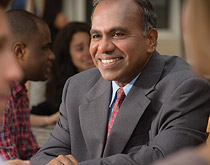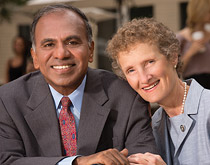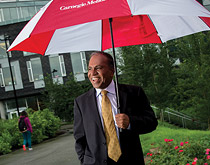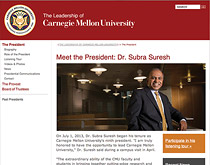
The long-awaited moment had arrived. Nearly three weeks earlier, a Carnegie Mellon news release had revealed the two-year search to find President Jared L. Cohon’s successor had successfully concluded. Subra Suresh would become the university’s ninth president on July 1. But it wasn’t until this day, February 21, when the university community would have its first chance to hear him speak, as part of CMU’s official welcoming of Suresh and his family. When he stepped onto the stage of the University Center’s McConomy Auditorium, those in attendance, as well as a worldwide audience (over a live Web cast), waited with excitement and anticipation to hear his first words. [see "CMU Welcomes Dr. Subra Suresh" video end of this article.]
After giving some initial thanks to all who had made him and his family feel at home, he took a moment to reflect on how far he had come in 56 years—from his birth in India to his appointment as president of a renowned university:
“In 1977, at age 21, with money borrowed for a one-way ticket and less than $100 in my pocket, I came to the United States, to Iowa State University in Ames. So, by now, you have figured out why I speak with an Iowa accent.”
Chuckles filled the auditorium while Suresh smiled, having taken care of any introductory tension.
His improbable journey actually began long before 1977. Suresh was born in 1956 into a “lower middle class family” in South India. Neither of his parents had a college degree. His father had a job with the local government while his mother stayed at home with Suresh and his younger sister, Chitra, who was born in 1960.
Not long after Suresh’s sister was born, his mother realized what many parents do—having a second child can make life interesting. “We didn’t have babysitters or even kindergartens,” he recalls. “So one day, she just took me to the local public school and said, ‘Can you take him in first grade?’ I was 4 years old and from then on would always be a couple years younger than the rest of the class.”
The age difference certainly didn’t bother him. He graduated second in his high school class, which at that time in India, ended after 11th grade. Next, thanks to a scholarship, came one year of pre-university education as a precursor to what many call the most competitive exam in the world—the entrance exam to the Indian Institutes of Technology (IIT), which was taken by Indian students nationwide at the same time. The test took two full days and, regardless of a particular student’s preferred track, consisted of four exams: math, physics, chemistry, and English.
Those who did well, at the time the top “1,200 to 1,500,” would gain acceptance to one of the five distinguished IIT campuses for an essentially free education. The others, several hundred thousand, would have to make other plans. For Suresh, other plans likely meant not going to college.
Turned out, there was no need for him to worry about a contingency plan. “I got in,” he says with a touch of pride. So, beginning in 1972, at the age of 16, he studied mechanical engineering at IIT, Madras. Five years later, he and about 80% of his graduating class left India to pursue graduate degrees in the United States. Iowa State had offered him a full scholarship for a “solid education.” Once settled, conversations with his family took place through weekly hand-written aerograms.
He had come a long way from being a four-year-old first-grader in South India, but his journey was just getting started:
1977-79
MS from Iowa State University, mechanical engineering.
1979-81
ScD from MIT, mechanical engineering. (He successfully defended his thesis in less than two years, one of the fastest doctorates earned in MIT’s history.)
1981-83
Postdoctoral research at Cal-Berkeley and the Lawrence Berkeley National Laboratory.
1983-93
Brown University, Professor of Engineering. (Tenure in 1986: “I thought I’d retire there.”)
1993-99
MIT professor. (“It was an opportunity to change my research directions.” He was appointed to MIT’s Richard P. Simmons Professorship in Materials Science and Engineering, a chair created to honor the Pittsburgh-based industrialist and philanthropist. The MIT department head at the time, Merton Flemings, says: “I was looking for a senior faculty member who could bring added strength to the department. Subra’s work was clearly at a very high level, and there were other people in the field whose reputation I valued who spoke highly of him, both for his teaching and research. We knew of no one who had his unique capabilities. He was our only choice.”)
2000-06
MIT department head of Materials Science and Engineering.
2002
Cofounded with Ares Rosakis, the dean of engineering at Cal Tech, a startup called Oraxion Diagnostics, which developed quality control technology for silicon wafers used to create chips for the microelectronics industry. The company used laser technology, held a dozen patents, and at one time had 30 employees before being purchased by Ultra Tech. Rosakis recalls the company’s origin: “Subra and I were having coffee in one of the student cafeterias [during a visit to Cal Tech by Suresh], and we were discussing some of our academic papers. Afterward, we walked directly to the Cal Tech Licensing Office where we proposed our startup idea.”
2006-07
Appointed by MIT to lead the process that established the Singapore MIT Alliance for Research and Technology (SMART)—MIT’s first overseas research center, which now actively engages several hundred faculty, students, and researchers from MIT and Singapore.
2007-10
MIT Dean of the College of Engineering. (“Being the dean of engineering at MIT is special; it’s leading a very large administrative operation, essentially 40% of MIT.”)
2010-13
Director of the National Science Foundation (NSF). (“I couldn’t say, ‘No’ to the President of the United States.” Appointed by Barack Obama and unanimously confirmed by the U.S. Senate, he led the independent federal agency with an annual budget of $7 billion.)
2013
President of Carnegie Mellon University. (“It is a chance to lead a university world renowned for its unique ability to bring together innovation, entrepreneurship, interdisciplinarity, creativity, and scholarship.”)
WHAT IS IT THAT MADE HIM SUCH A VIABLE CANDIDATE TO GO from one prestigious position to another?
“He is one of the most creative and innovative people I have ever met,” says Alan Leshner, who has met a lot of people. He is the CEO of the American Association for the Advancement of Science, which is the world’s largest multi-disciplinary scientific and engineering society. By the time Suresh became NSF director, Leshner was well aware of all he had accomplished:
Suresh started out as a mechanical engineer with specialization in properties of materials, an interdisciplinary field connecting various areas of science and engineering; he has become one of the most-cited scientists in the field. Although his recent contributions, linking cell biomechanics with human diseases, may sound esoteric to most of us, the impact can touch all of our lives. In 2006, Technology Review magazine selected Suresh, for his work on nanobiomechanics, as one of the top-10 researchers in emerging technologies that will have a significant impact on business, medicine, or culture. And, earlier this year, he received the Franklin Institute’s Benjamin Franklin Medal in Mechanical Engineering and Materials Science for outstanding contributions to our understanding of the mechanical behavior of materials in applications ranging from large structures down to the atomic level. This research also showed how deformation of biological cells can be linked to human disease.
No one would question his intellect, not even President Obama, who appointed Suresh as director of the NSF, an organization that has supported 35% of all those who have won Nobel Prizes since 1950. But Suresh’s intellect is only one part of his story.
Not long after he arrived at MIT, he happened to pass in the hallway the university’s president, Charles M. Vest. Suresh mentioned to him he had read his book on holographic interferometry. Vest says he responded by saying, “I’m sure you’re the only faculty member at MIT who has ever read it.” But Suresh wasn’t kidding “Turns out,” says Vest, “it was a tool he had used in some of his research at Brown, so he knew a little bit about the field.” That day, Suresh had put an extra bounce in the step of the MIT president.
Like Leshner, Vest also found Suresh to be creative and innovative:
“One of the first things that became apparent both in his own work, which he continued as department head, and even as dean, was this sort of bridging into what is really interdisciplinary work. Not lip service, but really interdisciplinary work between the mechanical and material side of engineering and life sciences. He also managed to recruit some very young superstars who were working in these really new areas, and he hired first-rate women for the faculty, which previously had been lacking. That always jumps out to a president.”
Something else jumped out to Vest about Suresh’s leadership qualities. “It may sound trivial, but it wasn’t at all; the teaching labs were along a relatively dismal hallway at MIT, but it’s a hallway that every student walks past virtually every day, almost no matter what field they are in. Subra opened that space up with glass so that the whole world passing by could see what was going on. It may sound like a simple thing, but it set a tone.”

Suresh’s wife, Mary, has also witnessed the importance her husband places on people and on relationships beyond a résumé. She says many of his first students at Brown, some 30 years ago, continue to keep in touch: “It means a lot to him to establish relationships with students that often grow beyond the classroom or research lab, providing rich friendships that our family values to this day.”
As for their relationship, it started by chance. Suresh had completed a postdoc in California, and—in the fall of 1983—with “all of my earthy possessions packed in my small car,” he drove cross-country to New England, where he would begin teaching at Brown. Barely settled, one of his buddies from his graduate school days at MIT told him about a party happening in Boston at his friend’s place. Suresh drove there. Around 10 pm, he decided to head back to Providence: “It was so cold I was afraid my car would stall, and I had a 60-mile drive home. Plus I had to write my first proposal the next day.”
No one else was in a rush to get home, and the party was so packed that he couldn’t move when he neared the doorway. Also unable to move was someone who had just arrived, Mary.
“We were literally in a gridlock situation,” she recalls. “He was leaving, and I was arriving. We ended up talking about his travels, he had just come from the West Coast and was leaving shortly thereafter for Europe.” Prompted by her curiosity, he asked: “Would you like to see my travel photos sometime?” They both laughed.
“I was very intrigued with his background,” she says. They ended up going out a few times, and then he invited her to his place in Providence where he prepared the dinner.
“He didn’t measure anything,” she fondly recalls. “He started with some rice, cut up a few potatoes, added some frozen vegetables, all while he was still talking. Then, he poured in water, some salt and spices, put on the lid, on and turned on the burner. I wondered whether we were going to be chomping on raw vegetables and undercooked rice.”
After her first bite, she says it was compliments to the chef. “I was captivated by his confidence and positive attitude,” she says, from cooking to his career to their relationship.
They married in 1986 and have two children: Nina, an MIT graduate, is a medical student at the University of Massachusetts Medical School; and Meera, a Wesleyan graduate, who is completing a fellowship at the National Institutes of Health, working with children in the National Institute of Mental Health.
Mary Suresh says she’s delighted to join the CMU community with her husband. She earned a BS in nursing and a Master’s in Public Health and was director of public health in the town of Wellesley, Mass., from 2006-2011, so it’s no surprise when she says she’s excited at the possibility of becoming active in public health initiatives at CMU and throughout the region.
Her husband is excited to get started, too. It doesn’t take long for him to implement change, based on his most recent track record at the NSF, which includes these initiatives he conceived:
Innovation Corps
Getting research breakthroughs beyond the labs and into the appropriate marketplace through funding three-pronged teams that include the principal investigator, a postdoc, and an entrepreneurial mentor.
INSPIRE (Integrated NSF Support Promoting Interdisciplinary Research and Education)
Supporting high-risk interdisciplinary research that usually falls through the cracks because of traditional ways of identifying new ideas.
Career-Life Balance Initiative
First lady Michelle Obama kicked off this initiative. It helps scientists balance work and family responsibilities, permitting them to put their grants on hold for childbirth or adoption as well as parental leave. It also established grant subsidies to cover research technicians during the principal investigator’s family leave. (Although 40% of all STEM [science, technology, engineering, and mathematics] PhDs are women, they represent only 26% of the STEM workforce. This family-friendly initiative is meant to help rectify that imbalance.)
PEER (Partnerships for Enhanced Engagement in Research)
Working together with the U.S. Agency for International Development (USAID) to connect scientific research with global development challenges.
Global Research Council
A forum of scientific funding agencies from nearly 50 countries—which together oversee most of the global scientific budget—in order to establish uniform policies and procedures.
GROW (Graduate Research Opportunities Worldwide)
A partnership between NSF and international funding agencies that provides NSF Graduate Research Fellows with expanded opportunities to enhance professional development through research collaborations overseas.
Leshner, who sits on the board of the NSF, says these initiatives should continue to move forward without Suresh at the helm because “Subra’s style is such that he brought so many people into the discussion processes that they have ownership of them as well.”
President Obama gave Suresh his best wishes for the move to Carnegie Mellon. “I met him at the White House,” says Suresh, “and thanked him for the opportunity to serve.”

The president, in a statement released February 5, said: “We have been very fortunate to have Subra Suresh guiding the National Science Foundation…. Subra has shown himself to be a consummate scientist and engineer—beholden to evidence and committed to upholding the highest scientific standards. He has also done his part to make sure the American people benefit from advances in technology, and opened up more opportunities for women, minorities, and other underrepresented groups. I am grateful for his service.”
Ray Lane, the university’s Chairman of the Board of Trustees, is “thrilled” that Suresh is the one who emerged from hundreds of presidential candidates. He describes the ninth president of Carnegie Mellon as having the kind of character and drive to lead CMU’s evolution to even greater prominence than it enjoys today: “I assured him that the trustees are supportive of moving aggressively on new programs that position Carnegie Mellon for worldwide preeminence in the next decade.”
Suresh is quick to point out that he’s not about making change for change’s sake. Rather, it’s about further enhancing the global stature of CMU by nurturing the university’s interdisciplinary approach in what he calls the “intersection” of technology with business, education, entrepreneurship, fine arts, humanities, public policy, and science.
DON'T EXPECT CHANGES OVERNIGHT, THOUGH. First on his agenda, he says, is “a listening tour.” He plans to hold forums that include students, faculty, staff, and alumni to get “different perspectives.”
Suresh’s plan to immediately engage with the university community is exactly what was expected by Vest, now MIT President Emeritus and President Emeritus of the National Academy of Engineering. “I thought of [Suresh and CMU] as a terrific match from the first time he mentioned it,” he says. “Subra is somebody who likes to walk the hallways and know his colleagues and students as I did at MIT, and as I know Jerry Cohon has done. Subra is not the kind of person who is going to look for a prestigious job where he just sits in an office and doesn’t interact with the real world.”
The Listening Tour [see below] is now underway. However, there was one bit of advice that preceded the tour. It came from President Emeritus Cohon back at February’s Suresh Welcome on campus: “NEVER, EVER joke about the Steelers…. From your years at Brown and MIT you may be a Patriots fan, but never admit it in public.”
So far, on and off the record, Suresh hasn’t admitted anything. He’s off to a good start.
Robert Mendelson is executive editor of this magazine. Images by Harry Giglio (A'75)
LISTENING TOUR

Submit Questions or Comments for President Suresh
“I welcome any thoughts or ideas about the future of the university. I may not be able to respond personally to everyone, but everyone’s comments will be helpful to me.”
—Subra Suresh
As promised, Dr. Subra Suresh has embarked on his Listening Tour since taking office as the ninth president of Carnegie Mellon University on July 1, 2013.
Through the next several months, he wants to hear anything and everything that the university community has on its mind. The input will help him in developing strategies for building upon the momentum that has made the university a world-renowned institution.
To have your voice heard by Dr. Suresh, simply submit to him your
questions, suggestions, or concerns through the university’s website.
www.cmu.edu/president-suresh (click on Listening Tour)
—or write to—
Subra Suresh Listening Tour
Carnegie Mellon University
5000 Forbes Avenue
Pittsburgh, PA 15213
Related Links:
Flickr: CMU Welcomes the Suresh Family (photos)
Subra Suresh Assumes Presidency
Message from President Subra Suresh
CMU Welcomes Dr. Subra Suresh



